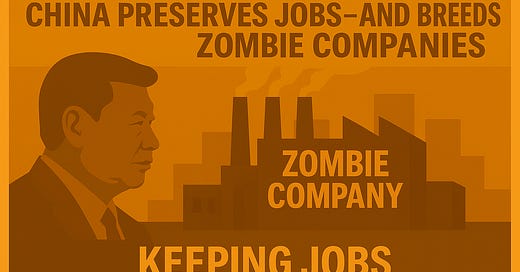China saves jobs - and breeds zombie companies
China is saving jobs at all costs - even if it means artificially keeping zombie companies alive. The consequences for the economy and the global market are serious.
China is saving jobs and accepting far-reaching economic distortions to do so. To prevent redundancies and social unrest, the government is deliberately keeping companies alive that are no longer competitive. The officially low average unemployment rate of 5.2 percent this year, reported by the National Bureau of Statistics, gives the impression of economic stability. However, this figure conceals an economy that is suffering from weak growth and stagnating domestic demand. Many companies can only continue to produce with government aid and intervention. Instead of reducing overcapacity and increasing productivity, those responsible are preventing a market shakeout. In this way, economic efficiency is sacrificed in order to maintain employment and social peace at all costs.
Generated by AI (DALE-E3)
Zombie companies ensure China's social tranquillity
A vivid and stereotypical example is Daun Automobile, an electric car manufacturer in Shanxi province. Celebrated for its job creation like many carmakers, the company fell into disarray after its peak in 2017 when its attempt to switch to premium electric cars failed. Despite tax breaks and subsidies for electric vehicles, Daun had to undergo a court-ordered restructuring in 2024. Nevertheless, it continues to produce trucks, a sign of the reluctance of local authorities to allow market exits. Such cases are no exception. The proportion of loss-making industrial companies is now as high as it was in 2001, especially in the automotive industry. Although the market is oversaturated and the industry is suffering from debt, local and provincial leaders are allowing closures out of a mixture of misguided local patriotism and job creation.
The causes are complex. Domestic demand is stagnating, consumer confidence is suffering from the collapse of the real estate sector and global trading partners are reacting to China's overproduction with sanctions. Deflation, weakened confidence and a trade war, led by US tariffs under Donald Trump, are exacerbating the situation. Many exporters are facing tariffs of up to 30 percent, while anti-dumping investigations by the US, EU and other trading partners are restricting markets. Sectors such as steel, chemicals and automotive, where overcapacity is depressing prices, are particularly affected.
Reform backlog slows economic renewal
In the 1990s, Premier Zhu Rongji closed thousands of inefficient state-owned enterprises, which enabled China's production boom. Today, the overcapacity lies mainly with private companies over which local governments have less influence. Xi Jinping's prioritization of national security and technological self-sufficiency leaves little room for market volatility. Local officials are measured by growth and employment, which prevents them from closing unprofitable businesses.
Beijing is trying to tackle the problem. In 2023, the State Council issued guidelines to limit local subsidies and banks were instructed to stop lending to zombie companies. But implementation remains weak. In Shanxi, a former coal center that is reinventing itself as a clean energy hub, almost 40 percent of industrial companies are reporting losses - twice the national average. The province shows how deeply rooted the dilemma is: economic reforms clash with the imperative of social stability.
Social stability above all else
The Chinese insolvency system is another stumbling block. Courts are reluctant to approve closures as judges are held liable for social unrest. A 2021 legal paper shows that courts are often obliged to defuse protests in advance before bankruptcies are approved. Defaults remain rare, but the inefficient allocation of resources harms the economy. "The lack of market discipline is hurting healthy companies," says the Chief Economist for Asia Pacific at S&P Global Ratings, Shaun Roache.
The social situation is tense. According to the China Dissent Monitor, protests increased by 41% year-on-year at the end of 2024. The government is reacting cautiously: 51.com or Qiánchéng in Chinese, a major recruitment platform, stopped publishing wage data, presumably to disguise the weakness of the labor market. The 2022 protests, which led to the end of the zero COVID policy, have further heightened sensitivity to social stability.
Overproduction exacerbates trade conflicts
The policy has far-reaching consequences. Michael Pettis, professor of finance at Peking University, emphasizes: "Policies to reduce job and revenue losses for companies may seem like a purely domestic problem, but since these policies lead to a faster increase in production than the associated consumption, they are also effectively trade policies." Subsidizing unprofitable enterprises increases production faster than consumption, further increasing China's high savings rate. As real estate investment is declining, this is leading to an export surplus, which is exacerbating global trade imbalances.
Some experts are pushing for solutions. Economist David Li Daokui proposes a quota system in which companies can sell production rights in order to reduce overcapacity in a market-oriented manner. However, Beijing shows little willingness to implement such measures. Instead, the government is focusing on short-term stability. This secures jobs, but slows down long-term growth.
The low unemployment rate is a deceptive success. It comes at the price of inefficient use of resources and growing trade tensions. Without reforms, China faces the threat of stagnation, which even the Communist Party cannot ignore. The government faces a difficult choice: either it risks social unrest through closures or it continues to sacrifice economic efficiency. The time for half-hearted measures is running out.





